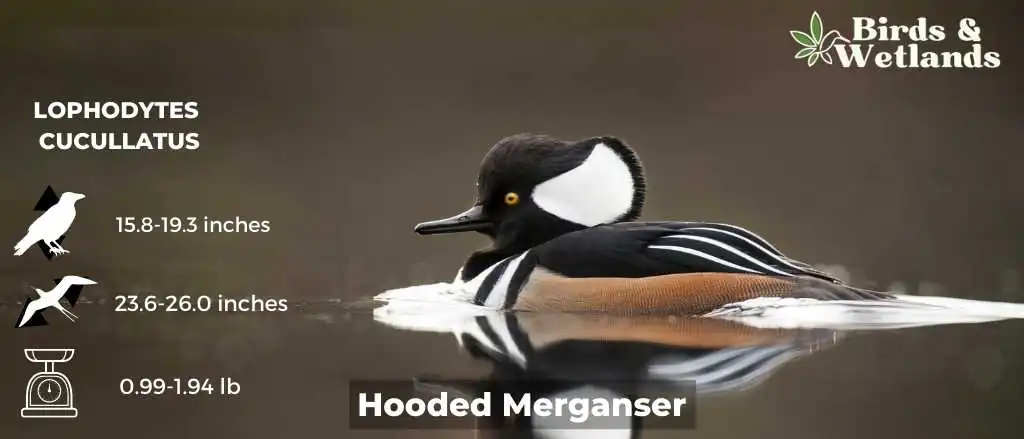
The hooded merganser (Lophodytes cucullatus) is the only merganser species native to North America. It is the only surviving species in the genus Lophodytes, which is derived from the Greek words lophos, meaning “crest,” and dutes meaning “diver”.
It is a small duck with a distinctive crest on its black head, which can be raised or lowered. Both sexes have a thin, serrated bill to catch and eat fish and other small aquatic creatures.
Scientific Name: Lophodytes cucullatus
Length: 15.8-19.3 in (40-49 cm)
Wingspan: 23.6-26.0 in (60-66 cm)
Weight: 16.0-31.0 oz (453-879 g)
Description
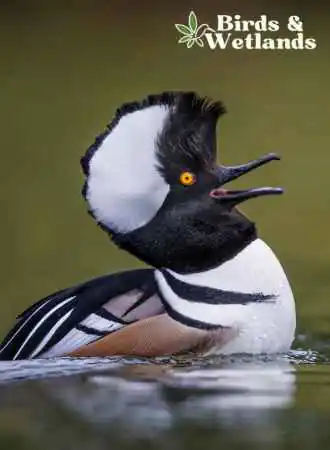
The adult male hooded merganser in breeding plumage has a white breast, chestnut flanks, a slender black bill, oversized head, and fan-shaped crest or hood, which can be raised or lowered. Raising and lowering the crest changes the shape of the head while also revealing a white patch of feathers on its head.
Its eyes are a bright yellow and contrast nicely against its dark plumage accented with white stripes. The legs are brown, with webbed feet that help it swim quickly and efficiently through the water.
An adult female hooded merganser has an attractive cinnamon to reddish-brown crest on its head and a gray-brown body that helps to camouflage the bird from potential predators.
It has a slender bill, mostly pale yellow at the base transitioning to darker colors near the tip. Its eyes are dark brown, and its feathers have black and white touches adding depth to their appearance.
Listen to Hooded Merganser
Appropriate Habitat
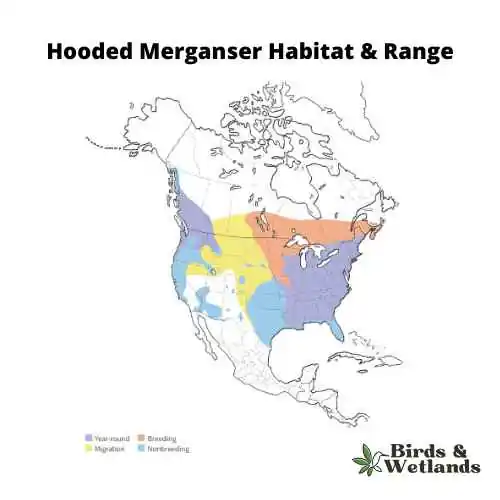
Hooded mergansers are found in various habitats, including freshwater wetlands, marshes, swamps, and rivers. They are often seen in wooded areas near small bodies of water and more open water bodies. These birds generally prefer shallow, vegetated areas where they can find plenty of food and cover.
In winter, the hooded merganser seeks out woodland ponds, forested wetlands, larger lakes, rivers, fresh water marshes, tidal creeks, wooded swamps and coastal estuaries. Marine waters are not its typical environment.
Interestingly, the hooded merganser is considered a freshwater generalist and is likelier than other ducks to venture far away with other hooded mergansers from their aquatic habitats in search of food.
Breeding Range
The Hooded Merganser is a North American species that breeds and winters across vast geographical regions. Breeding populations are abundant in the northern parts of North America. In the winter, many birds of this species migrate south but only for short distances.
Diet & Food Habits
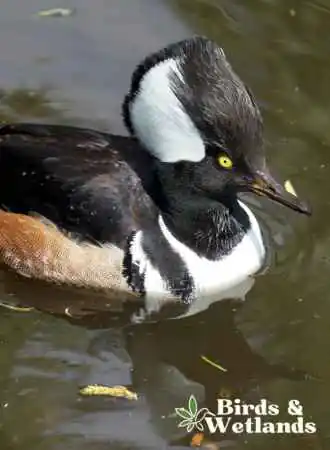
The Hooded Merganser possesses an omnivorous diet, consuming various aquatic animals and some plant matter. It feeds primarily on small fish but eats aquatic insects, clams, crabs, crayfish, tadpoles, frogs and aquatic invertebrates.
Additionally, small flocks have been observed to consume seeds and roots of aquatic plants on their wintering grounds and acorns.
To forage for food, the merganser utilizes various methods such as diving and swimming underwater, head-dipping and dabbling at the surface. They also have good underwater vision.
Nesting & Mating Habits
The breeding season starts from early March to late May.
Hooded mergansers nest in tree cavities, which is usually near marshes and small ponds. It readily accepts artificial nest boxes with wood shavings when available and often uses dead trees or old woodpecker holes for nesting.
It is fairly common for this bird to choose a cavity with some downy or sparse vegetation inside and a few feathers for cushioning. However, this is only sometimes the case.
The hooded merganser is known for its typically solitary nesting behavior. However, some instances have shown multiple females laying eggs in the same nest.
The female lays between 10 to 12 eggs and incubates them for 30 to 33 days. Shortly before the incubation begins, the male leaves the female to molt.
Once hatched, the downy ducklings are easily distinguishable by their dark brown feathers on their upper body and white on their underparts.
Within 24 hours from hatching, the young jump to the forest floor and head to the water. The female calls the young birds and lead them. Ducklings can search their own food, but the mother will tend to them for several weeks.
Population & Conservation Status
The current conservation status of hooded mergansers is “Least Concern”. However, the population has declined over the past few years due to the loss of nesting habitat and pollution.
Hunting
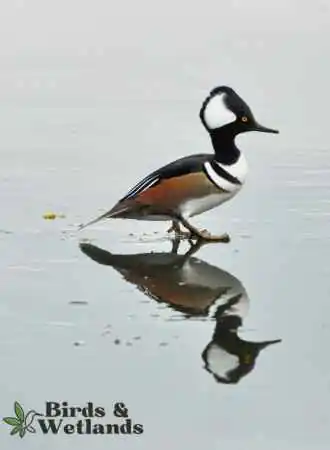
Yes, it is possible to hunt hooded mergansers in the United States. In fact, this species of duck is found throughout most of the country and is an extremely popular bird among hunters.
The hunting season for these ducks typically begins in September and lasts through February. However, certain states may have different start dates or extend the season length.
Furthermore, waterfowl hunters must be aware of the hunting regulations and limits in the state where they plan to hunt.
Key Points
- Female hooded mergansers are similar to other cavity-nesting ducks, such as wood ducks and common mergansers.
- Females will also lay eggs in a nest box.
- Some females lay eggs into others’ nests.
- Hooded mergansers are omnivorous, feeding on both animal and plant matter.
